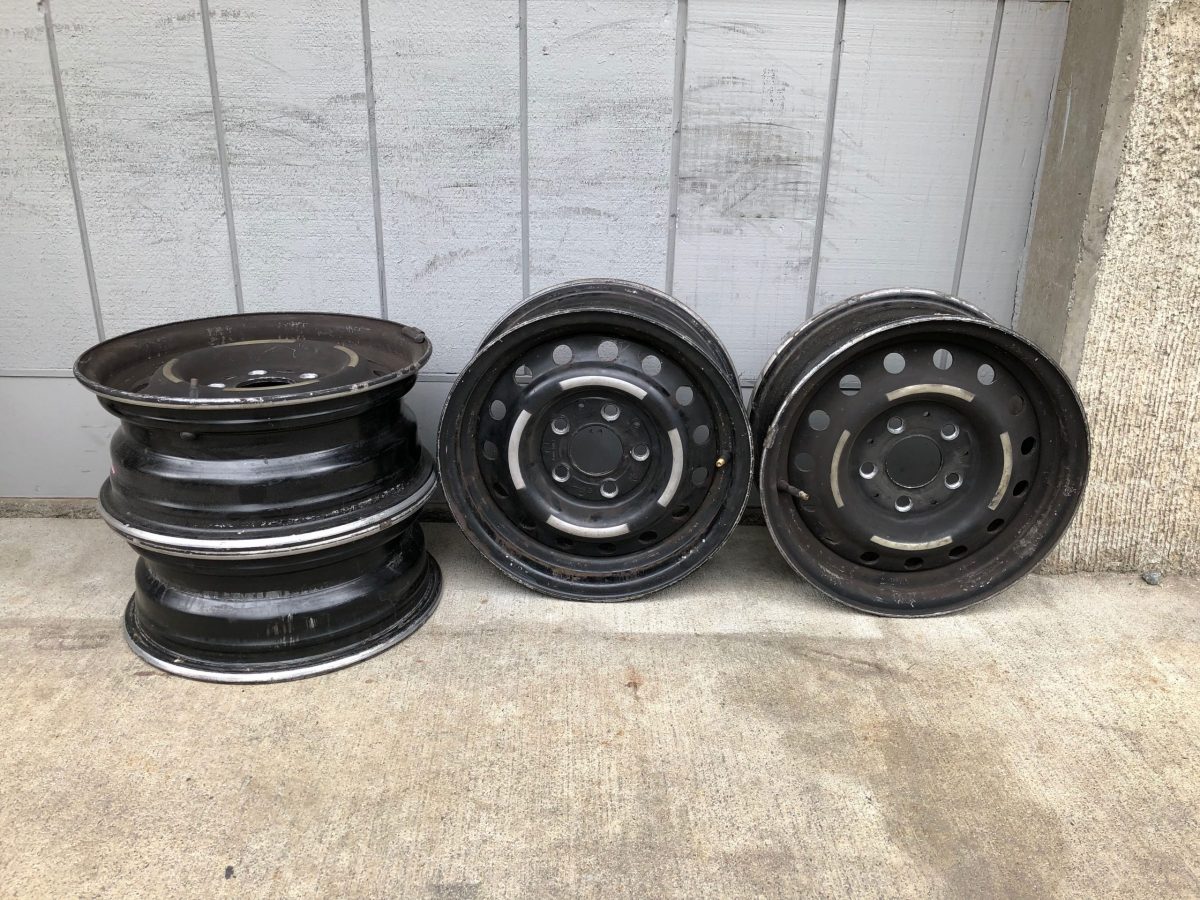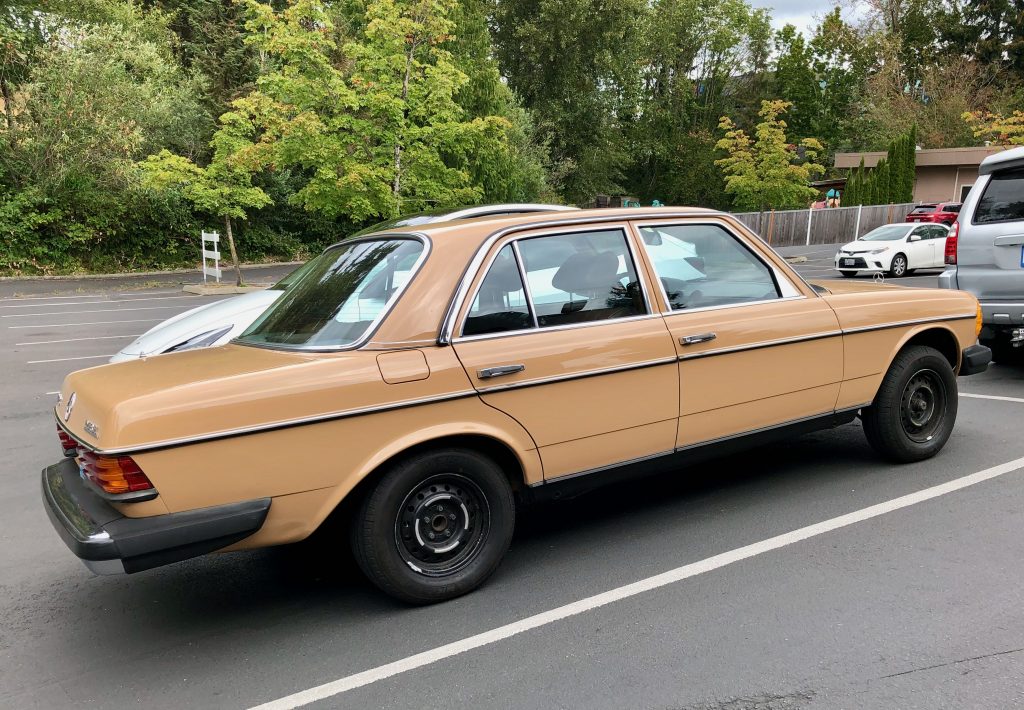New Wheels, Same Look: Fitting Aluminum “Steelies” to the 240D

One of the very best modifications you can make to a W123-series Mercedes is swapping its original 14-inch steel wheels for aluminum versions of the same. The aluminum rims (pictured above) are the same dimensions as the original “steelies” (14 x 5.5 inches). But they weigh half as much — just under 10 lbs each for the aluminum versions vs. almost 20 lbs for the steel ones.
Here’s why that matters.
Reducing Unsprung Mass
The wheels of a vehicle — along with its tires, brake rotors and calipers, axles, and any other components not supported by the suspension — are part of its “unsprung” mass, and reducing that mass is key to improving its performance. Race car builders have known this for decades, which is why many of them use fancy lightweight materials like carbon fiber and ceramic in the wheels and brakes. Some go to the extreme of mounting the brakes inboard in their quest to reduce unsprung weight.
Even a humble 240D, with just 62 horsepower, can benefit from this sort of change. That’s because when you reduce unsprung mass, it’s easier for the vehicle’s suspension to do its job, which is primarily to keep the tires in solid contact with the pavement.
Let’s say you hit a bump, which sends the wheel and tire upward. With a lighter wheel (and less unsprung mass), there’s less weight for the suspension to manage, so the springs and shocks can react faster and more effectively. That gets the tire back on track more quickly, with less disruption to the car and its occupants. And it results in less wear and tear on the suspension components.
Having lighter wheels also reduces rotational forces, which makes it easier to get the wheels moving, turn them, slow them down, or keep them spinning. That leads to improved acceleration, handling, braking, and even fuel economy — which is great for both race cars and street cars alike.

Finding Aluminum Steelies
Fortunately, it’s not too hard to find aluminum wheels for the W123. The model debuted in the middle of the 1970s oil crisis, when crude oil shortages drove gas prices through the roof and carmakers were scrambling to keep up with consumer demand for better gas mileage. That’s one reason Mercedes sold primarily diesel versions of the W123 in the US. Buyers wanted the diesel engine’s inherently better fuel economy.
During this period, Mercedes also started fitting more and more aluminum wheels from the factory. A popular option for the W123 (and many other Benzes) was the 15-spoke “Bundt”-style alloy wheel. Not only did its lighter weight (around 15 lbs) assist in improving performance and economy, its handsome design helped to differentiate more upscale models, such the 300D, from a base 240D like mine. (For more on Bundt-style wheels, see this excellent article on the Hagerty website.)
By the 1980s, Mercedes had also started to use aluminum versions of the standard W123 wheels (with hubcaps) on the 240D and other models in a continued effort to save weight. Mercedes called these “light alloy rims.” They look almost exactly like steel wheels but are made of lightweight aluminum alloy — hence their nickname of “aluminum steelies.” Those are the wheels that I was after.
Mercedes made aluminum steelies in two sizes. Both are 14 inches tall (like pretty much all other MB wheels at the time). The more common version, which was fitted to the 240D starting around 1981, is five and a half inches wide and is identifiable by four silver stripes on the face (pictured above and in the lead photo). (The part number is 1234001302.)
There’s also a six-inch version, which came on more powerful cars, such as the 280E. It’s somewhat rare and is identifiable by an unbroken silver stripe on the face. (The part number is 1234001502.) The wider version is a favorite swap for owners of the W113-generation SL roadster (aka the “Pagoda”), whose cars originally came with much heavier steel rims. The combo of desirability and scarcity means that the six-inch versions are pricey, with most going for well over $1000 a set.
Happily, I was content to stick with the cheaper 5.5-inchers for my 240D, and I was able to find a used set on eBay for $500 without much trouble. They can sometimes be had for even less money if you don’t mind hunting around on the forums for a while.

Making the Swap
Once the wheels arrived, I headed over to Sound Wheel Works on the east side of the Seattle area to have them installed. I wanted to make sure that the wheels were true before making the swap, and the owner there, who has been in the business for decades, knows as much about fixing up old wheels as anyone in the business. Fortunately, the wheels I bought only needed some slight adjustments, so I was in and out in about an hour.
I’ve made this upgrade with a few of the W123s I’ve owned, and I’ve always been pleased with the results. With the lighter wheels, there’s a noticeable difference in the way the car drives. It feels more nimble around town, more stable over rough pavement, and even a little quicker off the line. I haven’t filled up the 240D since making the change, but next time I do I’ll be curious to see if there’s any noticeable effect on its fuel efficiency. I’ll report on that in my next mpg update.
I also like the fact that this mod preserves the car’s traditional look. To my eye, nothing beats a W123 with color-keyed factory wheel covers. The original hubcaps snap right on, though a different clip is recommended (part number 1234000027). It has a nylon pad to help it slip onto the rim more easily and protect the aluminum from gouges. Don’t tell anyone, but I just used the original clips.
Since my car is so original, I made sure to grab the original steel wheels that it came with. I’ll keep them safely stored away in case some future owner should ever want to return it completely to stock.
Next Post: coming soon…